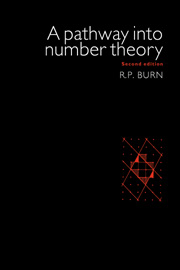Book contents
- Frontmatter
- Contents
- Preface to the second edition
- Introduction
- 1 The fundamental theorem of arithmetic
- 2 Modular addition and Euler's ɸ function
- 3 Modular multiplication
- 4 Quadratic residues
- 5 The equation xn + yn = zn, for n = 2, 3, 4
- 6 Sums of squares
- 7 Partitions
- 8 Quadratic forms
- 9 Geometry of numbers
- 10 Continued fractions
- 11 Approximation of irrationals by rationals
- Bibliography
- Index
- Frontmatter
- Contents
- Preface to the second edition
- Introduction
- 1 The fundamental theorem of arithmetic
- 2 Modular addition and Euler's ɸ function
- 3 Modular multiplication
- 4 Quadratic residues
- 5 The equation xn + yn = zn, for n = 2, 3, 4
- 6 Sums of squares
- 7 Partitions
- 8 Quadratic forms
- 9 Geometry of numbers
- 10 Continued fractions
- 11 Approximation of irrationals by rationals
- Bibliography
- Index
Summary
Quadratic residues and the Legendre symbol
1 Working in Z7, find all the solutions to x2 = 0, 1, 2, 3, 4, 5, 6 respectively.
2 In Z7, which of the equations
have no solution, have one solution, have two solutions?
3 The perfect squares in M7 are called the quadratic residues modulo 7. Exhibit the mapping of M7 given by x → x2. Does the set of images under this mapping form a subgroup of M7?
4 Use table 3.2 to find the quadratic residues modulo 5, 11, 12 and 13. For which of these moduli do the quadratic residues form a subgroup of Mn ? For which of these values of n is the mapping of Mn given by x → x2, two to one?
5 State the number of quadratic residues modulo 3, 5, 7, 11, 13 and 17 respectively. Predict the number of quadratic residues modulo p (an odd prime).
6 If x2 ≡ y2 (mod p), does it follow that either x = y (mod p) or x =-y (modp), when p is a prime number?
7 For any prime p, determine the elements of Mp which are mapped to 1 under the mapping x → x2. Can you say how many elements of Mp are mapped to any other quadratic residue under this mapping?
8 A number in Mn which is not a square is called a quadratic nonresidue modulo n. Find three quadratic non-residues modulo 12.
9 Find the cube of all the quadratic residues modulo 7, and also the cube of all the quadratic non-residues.
10 What does Fermat's theorem imply about the number of roots of x6=1 (mod 7)?
What can you deduce about the cube of a quadratic residue modulo 7?
By factorising x6- 1 and using Lagrange's theorem, q 3.57, deduce that at most three cubes are congruent to 1 (mod 7) and at most three cubes are congruent to —1 (mod 7).
11 Using the method of q 10, determine how many fifth powers are congruent to 1 (mod 11) and how many fifth powers are congruent to-1 (mod 11). Does the value of the fifth power determine whether the number is a quadratic residue or not?
Information
- Type
- Chapter
- Information
- A Pathway Into Number Theory , pp. 79 - 96Publisher: Cambridge University PressPrint publication year: 1996
